Connections for the STEM Classroom
GVSU faculty and area experts provide engaging ideas on current topics in research and education
Small Things Considered: How Very Tiny Housekeepers Run Our Very Big Hydrosphere
Bopi Biddanda, Tony Weinke, Jasmine Mancuso, Annis Water Resources Institute, Grand Valley State University, USA, Deb Dila, School of Freshwater Sciences, University of Wisconsin-Milwaukee, USA, Mani Villar-Argaiz, Juanma Medina-Sánchez, Juanma González-Olalla and Pre Carrillo, Instituto del Agua and Departamento de Ecología, University of Granada, Spain
Whenever we look up into the night sky and wonder if there is life out there somewhere, our minds conjure images of water worlds, because life, as we know it, is water-based. Ours is primarily a water planet located in the habitable, or “Goldilocks Zone” around the Sun. Indeed, the bulk of Earth’s biosphere is composed of water, wherein the bulk of life is microbial – both in terms of numbers and biomass of organisms. Microorganisms (or microbes), less than a tenth of a mm (100µm) in size, occur in counts of ~1 million cells per mL in natural waters ranging from your backyard puddle to the deep ocean. Thus, life in our planet’s hydrosphere is ultimately an interconnected global ecosystem run by microbes. However, even though microbes have run the affairs of our watery world for billions of years, they are now faced with unprecedented anthropogenic and climate change impacts that in turn have huge significance for land-dwelling life forms like us. In a recently published review in Life entitled “Housekeeping in the Hydrosphere”, we describe the key microbial housekeepers in Earth’s waters and discuss the everyday housekeeping chores they do – and ponder their significance in a rapidly changing biosphere.
Summary: Who's cooking, who's cleaning, and who's got the remote control within the waters blanketing the Earth? Tiny but numerically dominant and physiologically active, microbes are the “homemakers” of the watery household. Phytoplankton may be small, but their culinary abilities enable them to create food by absorbing sunlight to fix carbon and release oxygen, making them top-chefs in the aquatic kitchen. Ubiquitous heterotrophic microbes including prokaryotic bacteria and archaea, eukaryotic protozoa, and viruses, keep aquatic ecosystems tidy by recycling organic matter and making inorganic nutrients repeatedly available to primary producers. Grazing protozoa compete with the viruses for their fair share of available bacterial biomass, whereas mixotrophic protists both produce new organic matter and consume microbial biomass. When viruses alter their host’s genes or lyse them, the outcome can reverberate throughout the microbial community and beyond. Despite the recognition of the vital role of microbes in biosphere’s housekeeping, the impact of anthropogenic stressors and climate change on their biodiversity, evolution, and ecological function remains poorly understood. The “housekeeping” perspective can advance our understanding of how trillions of the smallest organisms in Earth’s largest ecosystem go about their daily chores keeping our planet habitable – even as the watery world around them is changing.
Highlights
- Essential microbial housekeepers cook, clean and control the hydrosphere.
- Microorganisms actively respond to environmental change in globally significant ways.
- The housekeeping perspective is essential to ecosystem studies at all scales (ponds to planet).
The House: Ecology is the study of the house – the prefix “eco” being derived from the common etymological Greek word “Oikos”, meaning “home, house, household, or economy”. The two words “ecology” and “economy” are both derived from “oikos” and describe one common discipline involving both the study of the household and the management of the household. The concept of ecology as the study of the household and its economy – including human-dominated ecosystems, makes good practical sense.
Today, however, we rarely come across ecological studies that view ecosystems – whether they are ponds or forests, oceans or the Earth – from a “house”, “household” or “economy of housekeeping” perspective. Clearly, the “house, household, and housekeeping” perspective is key to attaining a more personal and fuller understanding of the world around us – the ecosystems we live in. Our paper makes the case that “housekeeping” is a useful working concept for better science, education, and communication of ecosystem studies that is applicable to all ecosystems in general (Table 1) and to aquatic ecosystems in particular (Figure 1).
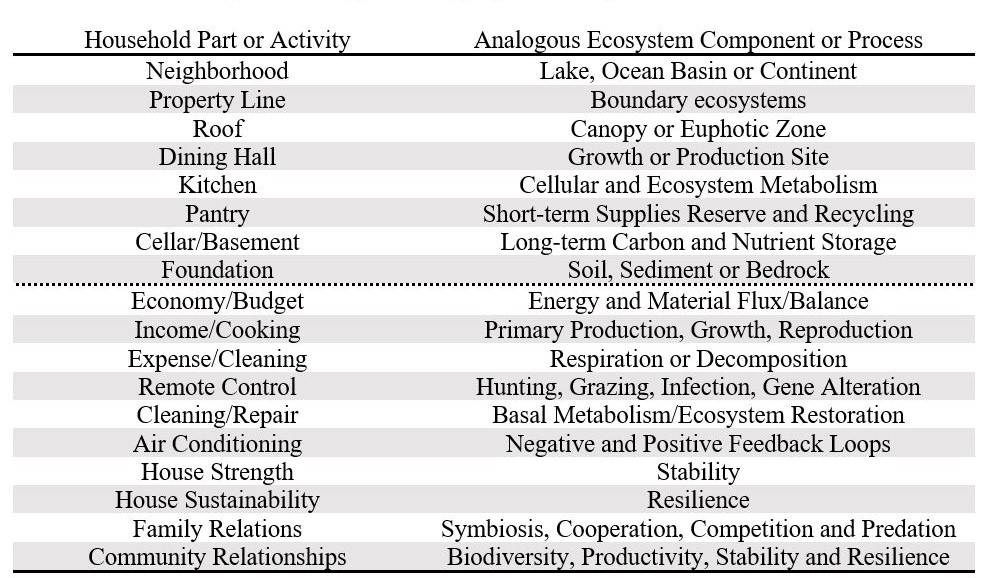
Table 1. Terms of analogy between Household and Ecosystem Parts and Processes. Note: The transition zone between Parts and Processes is indicated by the dotted line. Some, but not all, of these Household-Ecosystem analogies are highlighted in Figures 1 and 4.
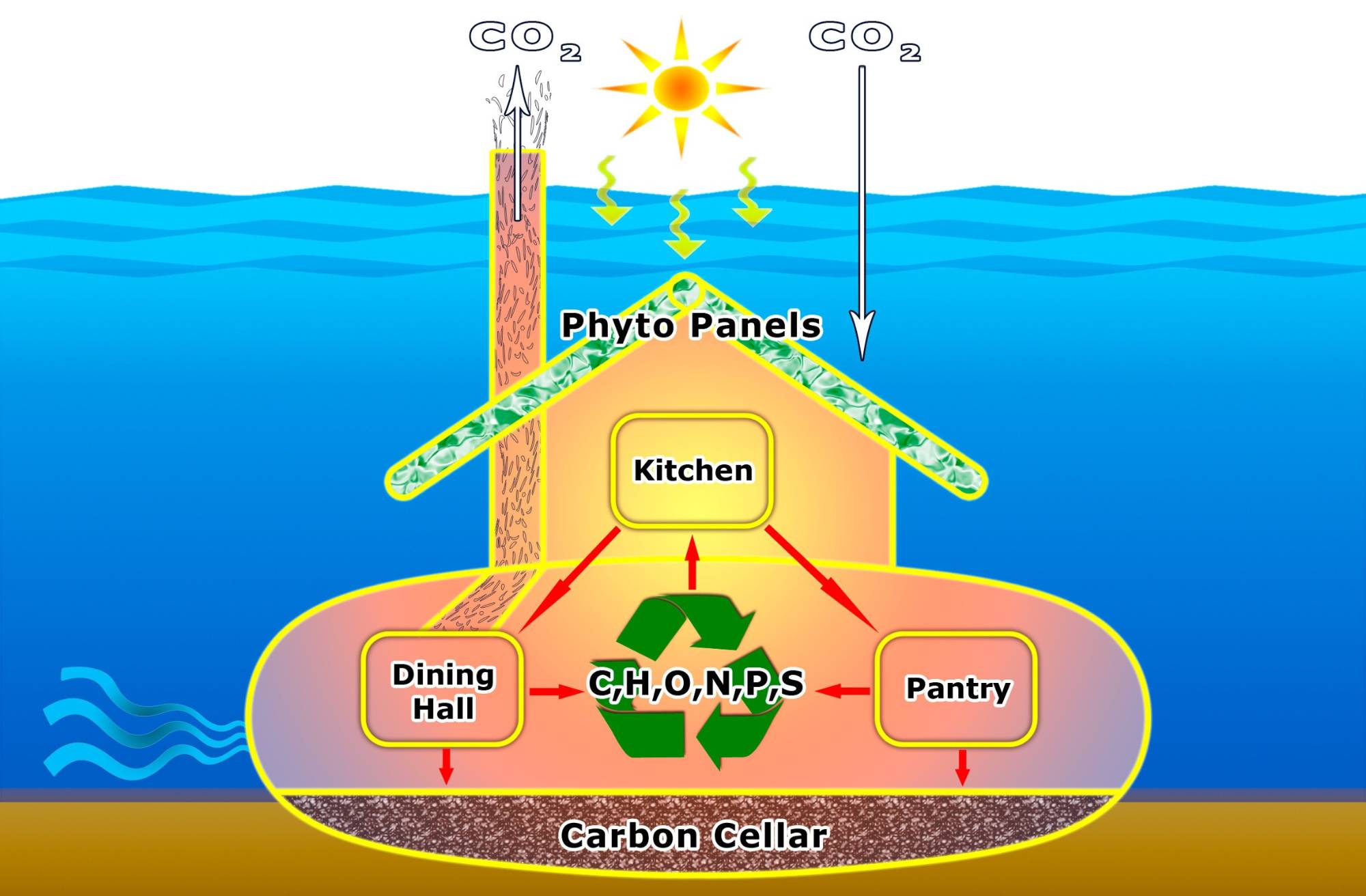
Figure 1. Underwater household: Simplified schematic diagram of microbial cooking, cleaning, and control in the aquatic household. Phytoplankton equipped with "Phyto Panels" prepare food in the “Kitchen” that is either utilized by viruses, bacteria, archaea, protozoa and metazoa in the “Dining Hall” or is stored in the “Pantry” for later use as dissolved and particulate organic matter. Whereas many of the elements essential to life first incorporated by phytoplankton are respired by the microbial food web or transferred to higher trophic levels, a small fraction escapes this fate and gets buried in the “Carbon Cellar” located in the sediment.
Housekeepers: The vast majority of aquatic housekeepers are small and are composed of phytoplankton, viruses, bacteria, protozoa and small zooplankton (Figure 2). In a world primarily covered by water, phytoplankton are responsible for roughly half of global net photosynthesis. Some of the cyanobacterial phytoplankton also fix valuable nitrogen – an element that is often in short supply in natural waters and can limit the growth of all organisms. Heterotrophic bacteria consume dissolved and particulate organic matter produced at all levels of the food web. Protozoa graze on bacteria and picophytoplankton, as do mixotrophic phytoplankton that both photosynthesize and graze. Smaller zooplankton and the larvae of large zooplankton are also important consumers of bacteria and smaller phytoplankton. Viruses exert control on all expanding microbial populations by infecting and lysing cells – and exchanging genes among all they infect. On the whole, microorganisms interact with each other, organic matter and inorganic nutrients in their surroundings intimately throughout the underwater household. Some of the microbial production ends up fueling the growth of larger organisms including zooplankton and fish. Overall microbial activity also determines how much of left-over production of organic carbon in surface waters gets buried in the sediments – and how much of the inorganic nutrients bound in organic matter are released for continued production.
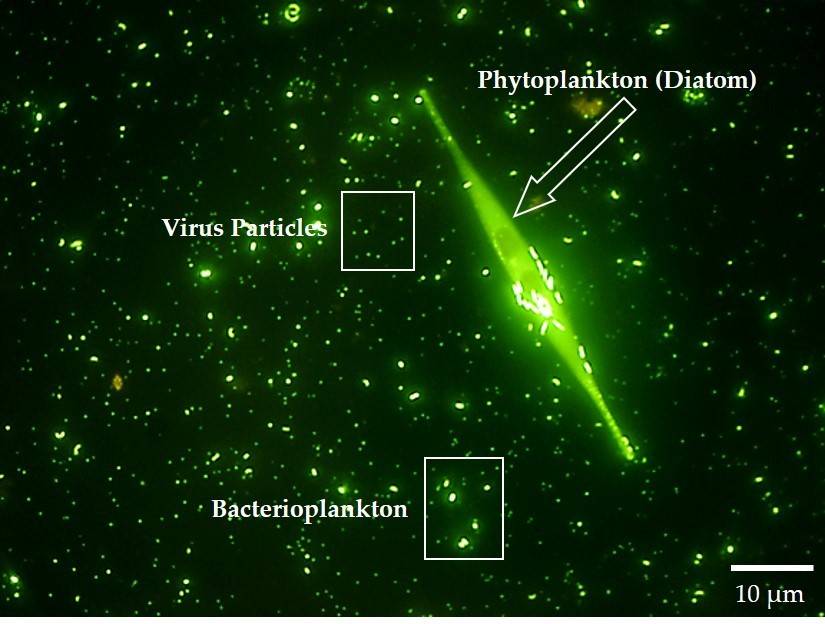
Figure 2. Like stars in the sky - microbial plankton of natural waters glow under the epifluorescence microscope: Underwater household where bacterioplankton and a UFO-shaped diatom float in a galaxy of viruses. This image of a microbial household residing in a major Lake Michigan tributary was stained with a nucleic acid-specific fluorochrome (SYBR Green) and photographed using a fluorescence microscope at 1000x magnification. In the background are common aquatic microbes: the smallest green specs are viruses; the larger ones are comprised of heterotrophic bacteria, archaea, and photosynthetic cyanobacteria. Note that some of the cyanobacterial cells are larger and dividing, ~1-2 µm in diameter.
Within our households, we need many different members that perform a wide variety of jobs. Extensive studies have demonstrated that high diversity and high evenness confer functional redundancy that enhance both ecosystem stability and resiliency. Furthermore, it is now becoming apparent that strong interrelationships between microbial diversity and ecosystem function are prevalent in microhabitats throughout the watershed. However, with increasing intensity and frequency of climate change and anthropogenic disturbances that reduce the diversity and stability of ecosystems, ecosystems are increasingly prone to regime shifts. Thus, conserving the diversity of microbes in nature may serve as the best bulwark against catastrophic changes in the future. Evidence for both latitudinal and altitudinal overlapping gradients in microbial biodiversity across the world’s watersheds are emerging. Maps of microbial households across the land-water continuum that include genomic and proteomic info should offer us insightful glimpses into both the changing structures and functions of microbial communities across the waterscape (Figure 3).
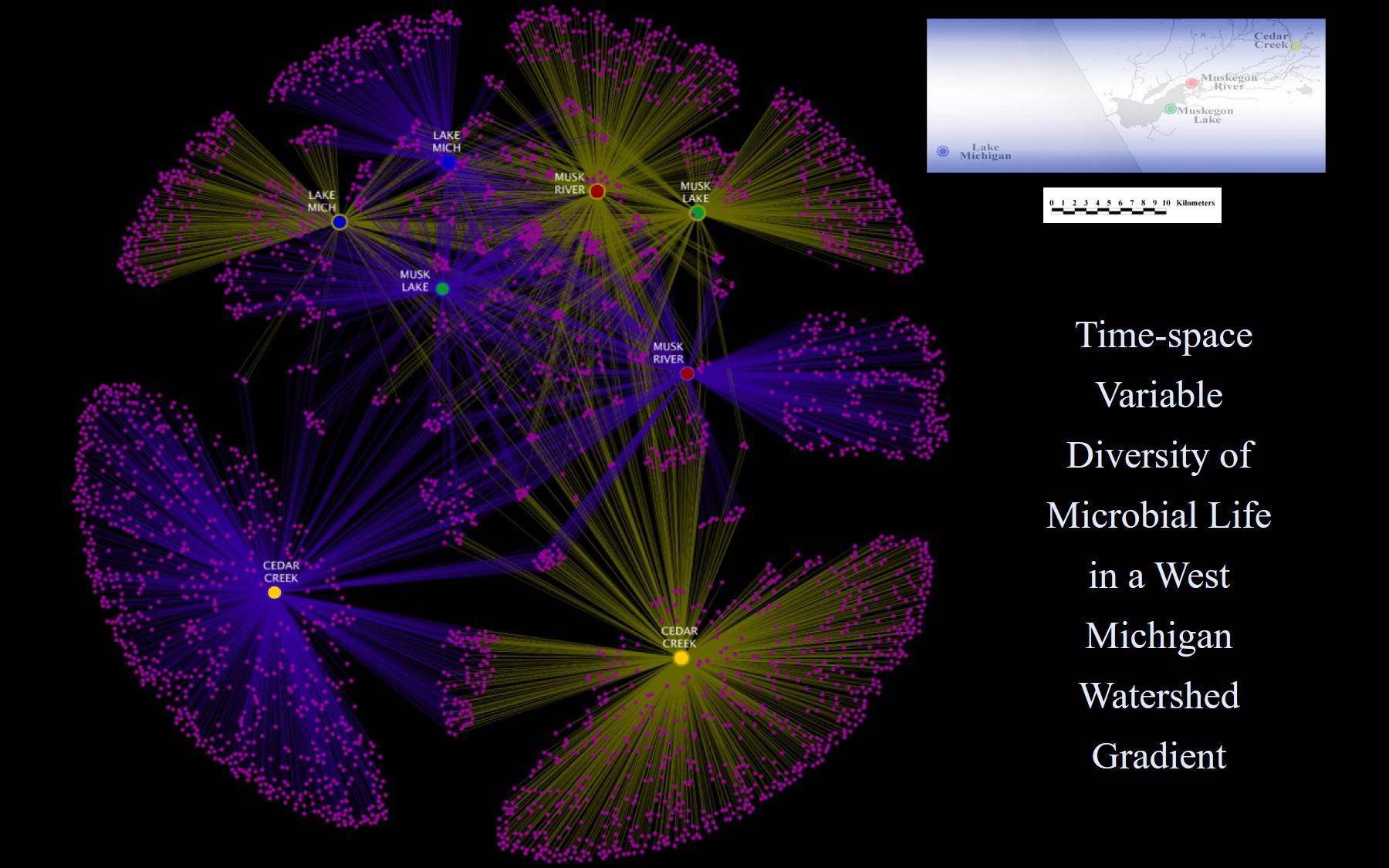
Figure 3. Time-space variable bacterial community diversity obtained by DNA sequencing of bacterioplankton from a West Michigan watershed. Note community changes as one goes from inland stream (Cedar Creek) to the open lake (Lake Michigan) as well as between summer (yellow lines) and winter (blue lines) seasons. In this network, purple dots are operational taxonomic units, which represent bacteria with different DNA sequences in their 16S rRNA gene. Dots that are not connected to more than one line are unique to the site they originate from. Thus, the inland stream Cedar Creek has the most diverse bacterial community in this watershed. Inset shows location of study sites along the ~35 km long land to lake transect.
Good Housekeeping: Microorganisms are important players in moving nutrients and energy through food webs and biogeochemical cycles in all ecosystems (Figure 4). The collective activities of microbes (e.g., primary production, consumption, growth, and recycling) keep the entire house running. Phytoplankton, including cyanobacteria photosynthesize organic matter that fuels the rest of the food web. Heterotrophic bacteria consume dissolved and particulate organic matter produced at all levels of the food web. They grow producing biomass, and respire, breaking down organic matter into inorganic nutrients – thus producing a “microbial loop” where waste organic matter from primary and secondary production is recycled back to primary producers. Protozoa graze on bacteria and picophytoplankton, as do mixotrophic phytoplankton that both photosynthesize and graze. Viruses often exert control on expanding populations by lysing cells of the dominant species (kill the winner scenario) and releasing cell-bound materials expediting the cycling of organic matter and nutrients via the “viral shunt’. Surplus organic matter produced at the surface can aggregate as “underwater snow” and sink through the water-column to the sediment, getting buried for the long term – constituting a part of the “biological pump” that removes carbon from surface waters. The impact of multiple stressors acting simultaneously on the outcome of microbial interactions is unclear – but some predicted responses are increased activity of the viral shunt and microbial loop and a decreased activity of the biological pump in a warming hydrosphere (Figure 4).
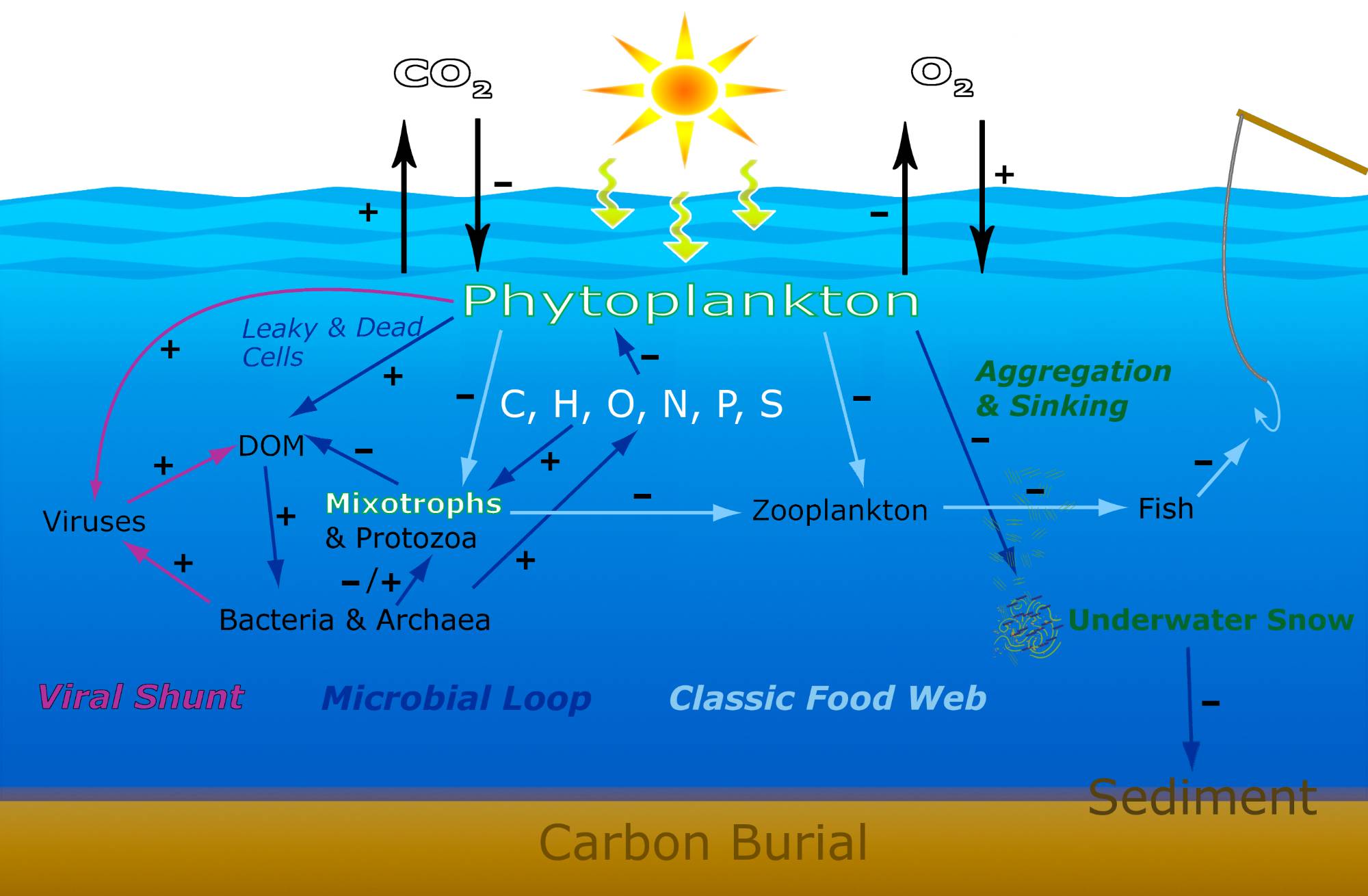
Figure 4. Dynamic Pathways of aquatic food webs and elemental cycles and the expected microbial responses in a changing aquatic world. Signs + and – indicate expected increase or decrease in response to anthropogenic and climate change stressors, such as changes in aquatic primary production and its role as a carbon sink. In what manner and to what extent microbial feedback processes will respond to increasing intensities of anthropogenic stressors and climate change and what net effects will result from such complex interactions remain an unresolved but consequential issue.
Emerging Household Issues: From a housekeeping perspective (Figure 1; Table 1) applied to the aquatic ecosystems (Figure 4), we recommend the following future ecological studies that should be applicable to non-aquatic ecosystems as well:
- House Budget (relating to ecosystem productivity):
- Developing an accurate picture of the varying inventories and fluxes of materials and energy for the aquatic household.
- Figuring out the ongoing net change in global aquatic productivity under the ongoing stressors of anthropogenic perturbations and changing climate.
- Identifying the thresholds at which microbial ecosystems switch between serving as carbon sinks or sources.
- Mansions vs Tiny Houses (relating to scales and connections):
- Testing the relevance and applicability of established macroecological theories such as colonization, competition, succession, predation, trophic efficiency, etc. in microbial ecology.
- Understanding the Diversity-Productivity-Stability-Resiliency relationships of microbial ecosystems around the world.
- Studying the diversity and role of microbiomes in the ecology of animals and plants.
- Families are complicated (relating to challenging domestic dynamics):
- Exploring the interactive effects of multiple stressors on microbial ecosystems.
- Quantifying the relatively understudied roles of viruses, picophytoplankton, protozoa and mixotrophs in aquatic food webs.
- Fixing the house (relating to ever-changing ecosystem conditions):
- Assessing the value of microbial biodiversity and physiologies to pharmaceutical potential, pollution remediation, and climate change mitigation.
- Quantifying and predicting the spread of aquatic invasive species and diseases.
- Incorporating microbial processes into ecosystem models & climate change scenarios.
- Predicting microbial feedbacks, thresholds and the next “Jenga Moment” (when multiple stressors converge, leading to tipping points and systems collapse) for the biosphere from the microbe’s perspective.
- Utilizing the housekeeping framework to explore Earth’s ecosystems and potential extraterrestrial ecosystems we may encounter.
Housework is Never Done: An invisible microbial network stretches across the watery surface of our planet, whose pervasive structure and emergent function bear close scrutiny. In fact, many discoveries in microbial ecology can be used to broaden public view on microorganisms and the biogeochemical cycles they drive, demonstrating their integral relationship to our personal and planet's well-being. It is time to re-imagine the role of the everyday microbe.
Routines of housekeeping appear to be a familiar scenario, even among life's smallest organisms going about their everyday activities in Earth’s largest ecosystem (Table 1; Figures 1 and 4). Housekeeping activities of aquatic microorganisms slowly built the foundation of the biosphere, creating the theater in which a complex variety of life could unfold. Given that microbes have been changing Earth’s composition and in turn have been changed by Earth’s climate, they are ideal sentinels of change in a world undergoing rapid environmental transformation. In the future, aquatic microbes will be challenged to shoulder even greater housekeeping responsibilities in a warmer, polluted, defaunated and deflorated household – even as their own taxonomic diversity and physiologic potential has taken a hit. So, like good housekeepers everywhere, their work is never done…
Arguably, a more intimate understanding of the everyday housekeeping role of microbes in the soil, water and air would contribute to better stewardship of our biosphere here on Earth and advance the search for possible life in extraterrestrial water worlds that are out there…
Published source literature with open access:
Biddanda, B., Dila, D., Weinke, A., Mancuso, J., Villar-Argaiz, M., Medina-Sánchez, JM., González-Olalla, JM., and P. Carrillo. 2021. Housekeeping in the Hydrosphere: Microbial Cooking, Cleaning and Control Under Stress. Life doi: 10.3390/life11020152
https://www.mdpi.com/2075-1729/11/2/152
https://www.mdpi.com/2075-1729/11/2/152/pdf

